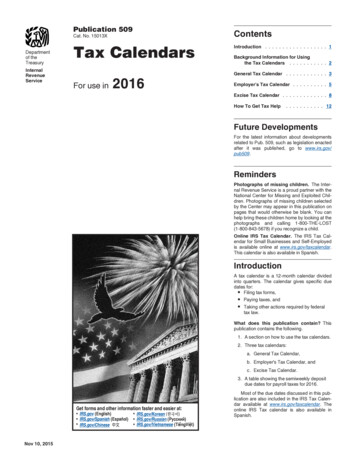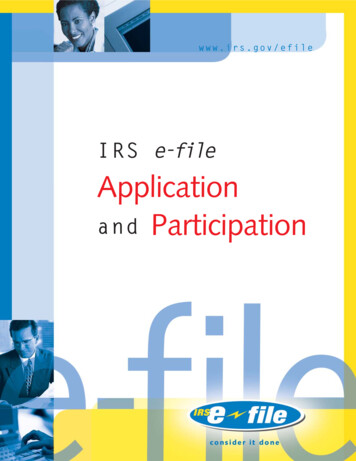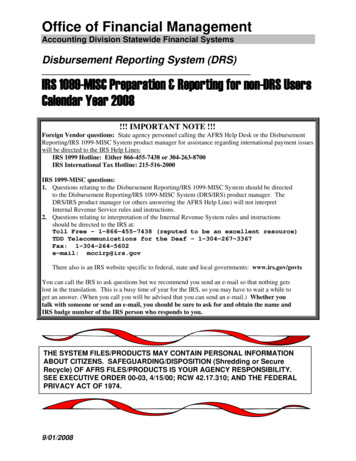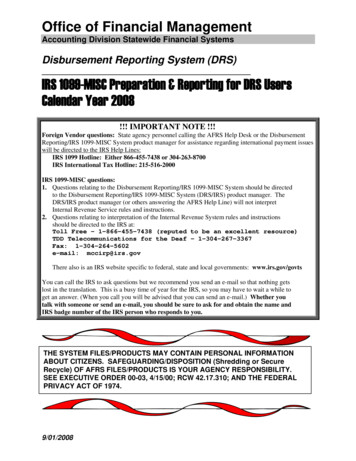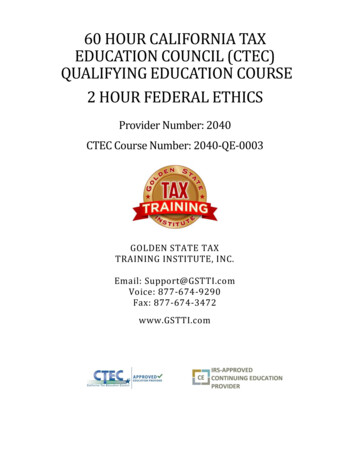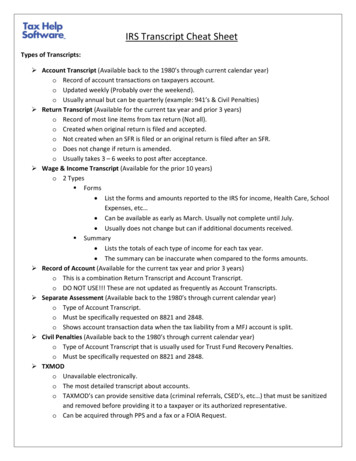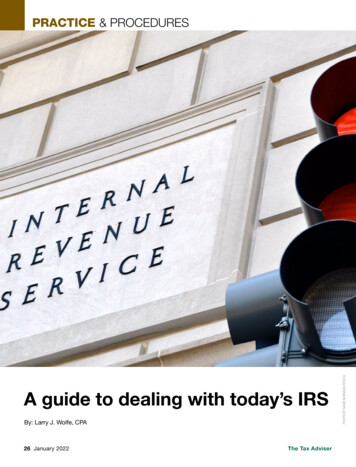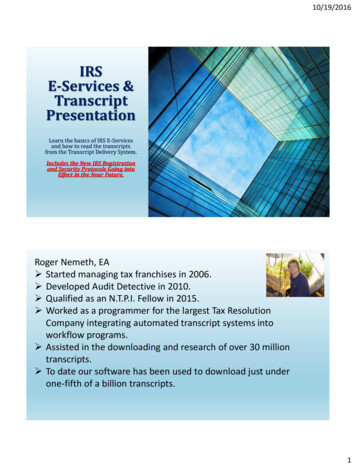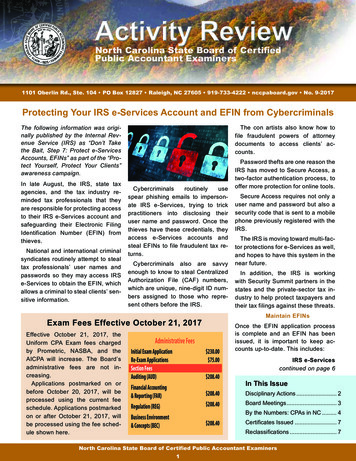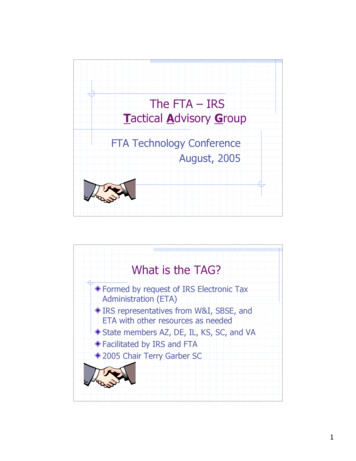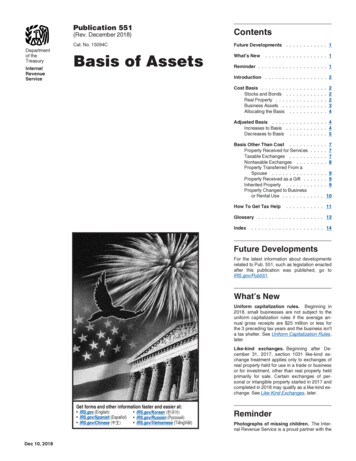
Transcription
Departmentof theTreasuryInternalRevenueServicePublication 551(Rev. December 2018)ContentsCat. No. 15094CFuture Developments . . . . . . . . . . . . 1Basis of AssetsWhat’s New. 1Reminder . . . . . . . . . . . . . . . . . . . . 1Introduction . . . . . . . . . . . . . . . . . . 2Cost Basis . . . . . . .Stocks and BondsReal Property . . .Business Assets .Allocating the Basis.22234Adjusted Basis . . . . . . . . . . . . . . . . 4Increases to Basis . . . . . . . . . . . . 4Decreases to Basis . . . . . . . . . . . 5Basis Other Than Cost . . . . . .Property Received for ServicesTaxable Exchanges . . . . . .Nontaxable Exchanges . . . .Property Transferred From aSpouse . . . . . . . . . . .Property Received as a Gift . .Inherited Property . . . . . . .Property Changed to Businessor Rental Use . . . . . . . .How To Get Tax Help.7778. 9. 9. 9. . . . 10. . . . . . . . . . . 11Glossary . . . . . . . . . . . . . . . . . . . 13Index. . . . . . . . . . . . . . . . . . . . . 14Future DevelopmentsFor the latest information about developmentsrelated to Pub. 551, such as legislation enactedafter this publication was published, go toIRS.gov/Pub551.What’s NewUniform capitalization rules. Beginning in2018, small businesses are not subject to theuniform capitalization rules if the average annual gross receipts are 25 million or less forthe 3 preceding tax years and the business isn'ta tax shelter. See Uniform Capitalization Rules,later.Like-kind exchanges. Beginning after December 31, 2017, section 1031 like-kind exchange treatment applies only to exchanges ofreal property held for use in a trade or businessor for investment, other than real property heldprimarily for sale. Certain exchanges of personal or intangible property started in 2017 andcompleted in 2018 may qualify as a like-kind exchange. See Like-Kind Exchanges, later.Get forms and other information faster and easier at: IRS.gov (English) IRS.gov/Spanish (Español) IRS.gov/Chinese (中文)Dec 10, 2018 IRS.gov/Korean (한국어) IRS.gov/Russian (Pусский) IRS.gov/Vietnamese (TiếngViệt)ReminderPhotographs of missing children. The Internal Revenue Service is a proud partner with the
National Center for Missing & ExploitedChildren (NCMEC). Photographs of missingchildren selected by the Center may appear inthis publication on pages that would otherwisebe blank. You can help bring these childrenhome by looking at the photographs and calling1-800-THE-LOST (1-800-843-5678) if you recognize a child.Useful ItemsYou may want to see:Publication463 Travel, Gift, and Car Expenses463523 Selling Your Home523525 Taxable and Nontaxable Income525Introduction527 Residential Rental Property527Basis is the amount of your investment in property for tax purposes. Use the basis of propertyto figure depreciation, amortization, depletion,and casualty losses. Also use it to figure gain orloss on the sale or other disposition of property.You must keep accurate records of all itemsthat affect the basis of property so you canmake these computations.This publication is divided into the followingsections. Cost Basis Adjusted Basis Basis Other Than Cost530 Tax Information for HomeownersThe basis of property you buy is usually itscost. You may also have to capitalize (add tobasis) certain other costs related to buying orproducing the property.Your original basis in property is adjusted(increased or decreased) by certain events. Ifyou make improvements to the property, increase your basis. If you take deductions for depreciation or casualty losses, reduce your basis.You can't determine your basis in some assets by cost. This includes property you receiveas a gift or inheritance. It also applies to property received in an involuntary conversion andcertain other circumstances.946 How To Depreciate PropertyComments and suggestions. We welcomeyour comments about this publication and yoursuggestions for future editions.You can send us comments throughIRS.gov/FormComments. Or you can write to:Internal Revenue ServiceTax Forms and Publications1111 Constitution Ave. NW, IR-6526Washington, DC 20224Although we can’t respond individually toeach comment received, we do appreciate yourfeedback and will consider your comments aswe revise our tax forms, instructions, and publications.Ordering forms and publications. VisitIRS.gov/FormsPubs to download forms andpublications. Otherwise, you can go to IRS.gov/OrderForms to order current and prior-yearforms and instructions. Your order should arrivewithin 10 business days.Tax questions. If you have a tax questionnot answered by this publication, checkIRS.gov and How To Get Tax Help at the end ofthis publication.530535 Business ExpensesPurchase of a business. When you purchasea trade or business, you generally purchase allassets used in the business operations, such asland, buildings, and machinery. Allocate theprice among the various assets, including anysection 197 intangibles. See Allocating the Basis, later.535537 Installment Sales537544 Sales and Other Dispositions ofAssetsStocks and Bonds544547 Casualties, Disasters, and Thefts547550 Investment Income and Expenses550559 Survivors, Executors, andAdministrators559587 Business Use of Your Home587946Form (and Instructions)706 United States Estate (andGeneration-Skipping Transfer) TaxReturn706706-A United States Additional Estate TaxReturn706-A8594 Asset Acquisition Statement8594See How To Get Tax Help near the end of thispublication for information about getting publications and forms.Cost BasisTerms you may need to know(see Glossary):Business assetsReal propertyUnstated interestThe basis of property you buy is usually its cost.The cost is the amount you pay in cash, debtobligations, other property, or services. Yourcost also includes amounts you pay for the following items. Sales tax. Freight. Installation and testing. Excise taxes. Legal and accounting fees (when theymust be capitalized). Revenue stamps. Recording fees. Real estate taxes (if assumed for theseller).You may also have to capitalize (add to basis)certain other costs related to buying or producing property.Loans with low or no interest. If you buyproperty on a time-payment plan that chargeslittle or no interest, the basis of your property isyour stated purchase price, minus the amountPage 2considered to be unstated interest. You generally have unstated interest if your interest rate isless than the applicable federal rate. For moreinformation, see Unstated Interest and OriginalIssue Discount in Pub. 537.The basis of stocks or bonds you buy is generally the purchase price plus any costs of purchase, such as commissions and recording ortransfer fees. If you get stocks or bonds otherthan by purchase, your basis is usually determined by the fair market value (FMV) or the previous owner's adjusted basis of the stock.You must adjust the basis of stocks for certain events that occur after purchase. SeeStocks and Bonds in chapter 4 of Pub. 550 formore information on the basis of stock.Identifying stock or bonds sold. If you canadequately identify the shares of stock or thebonds you sold, their basis is the cost or otherbasis of the particular shares of stock or bonds.If you buy and sell securities at various times invarying quantities and you can't adequatelyidentify the shares you sell, the basis of the securities you sell is the basis of the securities youacquired first. For more information about identifying securities you sell, see Stocks andBonds under Basis of Investment Property inchapter 4 of Pub. 550.Mutual fund shares. If you sell mutual fundshares acquired at different times and prices,you can choose to use an average basis. Formore information, see Pub. 550.Real PropertyReal property, also called real estate, is landand generally anything built on or attached to it.If you buy real property, certain fees and otherexpenses become part of your cost basis in theproperty.Real estate taxes. If you pay real estate taxesthe seller owed on real property you bought,and the seller didn't reimburse you, treat thosetaxes as part of your basis. You can't deductthem as taxes.If you reimburse the seller for taxes theseller paid for you, you can usually deduct thatamount as an expense in the year of purchase.don't include that amount in the basis of theproperty. If you didn't reimburse the seller, youmust reduce your basis by the amount of thosetaxes.Settlement costs. Your basis includes the settlement fees and closing costs for buying property. You can't include in your basis the feesand costs for getting a loan on property. A feefor buying property is a cost that must be paideven if you bought the property for cash.Publication 551 (December 2018)
The following items are some of the settlement fees or closing costs you can include inthe basis of your property. Abstract fees (abstract of title fees). Charges for installing utility services. Legal fees (including title search and preparation of the sales contract and deed). Recording fees. Surveys. Transfer taxes. Owner's title insurance. Any amounts the seller owes that youagree to pay, such as back taxes or interest, recording or mortgage fees, chargesfor improvements or repairs, and salescommissions.Settlement costs don't include amountsplaced in escrow for the future payment of itemssuch as taxes and insurance.The following items are some settlementfees and closing costs you can't include in thebasis of the property.1. Casualty insurance premiums.2. Rent for occupancy of the property beforeclosing.3. Charges for utilities or other services related to occupancy of the property beforeclosing.4. Charges connected with getting a loan.The following are examples of thesecharges.a. Points (discount points, loan origination fees).b. Mortgage insurance premiums.c. Loan assumption fees.d. Cost of a credit report.e. Fees for an appraisal required by alender.5. Fees for refinancing a mortgage.If these costs relate to business property, items(1) through (3) are deductible as business expenses. Items (4) and (5) must be capitalizedas costs of getting a loan and can be deductedover the period of the loan.Points. If you pay points to obtain a loan (including a mortgage, second mortgage, line ofcredit, or a home equity loan), don't add thepoints to the basis of the related property. Generally, you deduct the points over the term ofthe loan. For more information on how to deductpoints, see Points in chapter 4 of Pub. 535.Points on home mortgage. Special rulesmay apply to points you and the seller paywhen you obtain a mortgage to purchase yourmain home. If certain requirements are met, youcan deduct the points in full for the year in whichthey're paid. Reduce the basis of your home byany seller-paid points. For more information,see Points in Pub. 936, Home Mortgage Interest Deduction.Assumption of mortgage. If you buy propertyand assume (or buy subject to) an existingmortgage on the property, your basis includesthe amount you pay for the property plus theamount to be paid on the mortgage.Publication 551 (December 2018)Example. If you buy a building for 20,000cash and assume a mortgage of 80,000 on it,your basis is 100,000.Constructing assets. If you build property orhave assets built for you, your expenses for thisconstruction are part of your basis. Some ofthese expenses include the following costs. Land. Labor and materials. Architect's fees. Building permit charges. Payments to contractors. Payments for rental equipment. Inspection fees.In addition, if you own a business and use youremployees, material, and equipment to build anasset, don't deduct the following expenses. Youmust include them in the asset's basis. Employee wages paid for the constructionwork, reduced by any employment creditsallowed. Depreciation on equipment you own whileit's used in the construction. Operating and maintenance costs forequipment used in the construction. The cost of business supplies and materials used in the construction.Don't include the value of your own labor, or any other labor you didn't payCAUTION for, in the basis of any property youconstruct.!Business AssetsTerms you may need to know(see ciationFair market value (FMV)Going concern valueGoodwillIntangible propertyModified Accelerated Cost RecoverySystem (MACRS) propertyPersonal propertyRecaptureSection 179 deductionSection 197 intangiblesTangible propertyIf you purchase property to use in your business, your basis is usually its actual cost to you.If you construct, create, or otherwise produceproperty, you must capitalize the costs as yourbasis. In certain circumstances, you may besubject to the uniform capitalization rules (discussed next).Uniform Capitalization RulesThe uniform capitalization rules specify thecosts you add to basis in certain circumstances.Activities subject to the rules. You must usethe uniform capitalization rules if you do any ofthe following in your trade or business or activitycarried on for profit. However, see Exceptionsbelow. Produce real or tangible personal propertyfor use in the business or activity. Produce real or tangible personal propertyfor sale to customers. Acquire property for resale.You produce property if you construct, build,install, manufacture, develop, improve, create,raise, or grow the property. Treat property produced for you under a contract as produced byyou up to the amount you pay or costs you otherwise incur for the property. Tangible personalproperty includes films, sound recordings, videotapes, books, or similar property.Under the uniform capitalization rules, youmust capitalize all direct costs and an allocablepart of most indirect costs you incur due to yourproduction or resale activities. To capitalizemeans to include certain expenses in the basisof property you produce or in your inventorycosts rather than deduct them as a current expense. You recover these costs through deductions for depreciation, amortization, or cost ofgoods sold when you use, sell, or otherwise dispose of the property.Any cost you can't use to figure your taxableincome for any tax year isn't subject to the uniform capitalization rules.Example. If you incur a business meal expense for which your deduction would be limited to 50% of the cost of the meal, that amountis subject to the uniform capitalization rules.The nondeductible part of the cost isn't subjectto the uniform capitalization rules.More information. For more information aboutthese rules, see the regulations under section263A of the Internal Revenue Code and Pub.538, Accounting Periods and Methods.Exceptions. Beginning in 2018, you're notsubject to the uniform capitalization rules if youraverage annual gross receipts are 25 millionor less for the 3 preceding tax years and you'renot a tax shelter. See section 263A(i).In addition, the following are not subject tothe uniform capitalization rules. Property you produce that you don't use inyour trade, business, or activity conductedfor profit. Qualified creative expenses you pay or incur as a freelance (self-employed) writer,photographer, or artist that are otherwisedeductible on your tax return. Property you produce under a long-termcontract, except for certain home construction contracts. Research and experimental expenses deductible under section 174 of the InternalRevenue Code. Before 2018, costs for personal propertyacquired for resale if your (or your predecessor's) average annual gross receipts forthe 3 previous tax years don't exceed 10million.For other exceptions to the uniform capitalization rules, see section 1.263A-1(b) of the regulations.For information on the special rules that apply to costs incurred in the business of farming,see chapter 6 in Pub. 225, Farmer's Tax Guide.Page 3
Intangible AssetsIntangible assets include goodwill, patents,copyrights, trademarks, trade names, andfranchises. The basis of an intangible asset isusually the cost to buy or create it. If you acquire multiple assets, for example, an ongoingbusiness for a lump sum, see Allocating the Basis, later, to figure the basis of the individual assets. The basis of certain intangibles can beamortized. See chapter 8 of Pub. 535 for information on the amortization of these costs.Patents. The basis of a patent you get for aninvention is the cost of development, such asresearch and experimental expenditures, drawings, working models, and attorneys' and governmental fees. If you deduct the research andexperimental expenditures as current businessexpenses, you can't include them in the basis ofthe patent. The value of the inventor's timespent on an invention isn't part of the basis.Copyrights. If you're an author, the basis of acopyright will usually be the cost of getting thecopyright plus copyright fees, attorneys' fees,clerical assistance, and the cost of plates thatremain in your possession. Don't include thevalue of your time as the author, or any otherperson's time you didn't pay for.2. Accounts receivable, other debt instruments, and assets you mark to market atleast annually for federal income tax purposes.3. Property of a kind that would properly beincluded in inventory if on hand at the endof the tax year or property held primarilyfor sale to customers in the ordinarycourse of business.4. All other assets except section 197 intangibles, goodwill, and going concern value.5. Section 197 intangibles except goodwilland going concern value.6. Goodwill and going concern value(whether or not they qualify as section 197intangibles).Agreement. The buyer and seller may enterinto a written agreement as to the allocation ofany consideration or the FMV of any of the assets. This agreement is binding on both partiesunless the IRS determines the amounts are notappropriate.Franchises, trademarks, and trade names.If you buy a franchise, trademark, or tradename, the basis is its cost, unless you can deduct your payments as a business expense.Reporting requirement. Both the buyer andseller involved in the sale of business assetsmust report to the IRS the allocation of the salesprice among section 197 intangibles and theother business assets. Use Form 8594 to provide this information. The buyer and sellershould each attach Form 8594 to their federalincome tax return for the year in which the saleoccurred.Allocating the BasisMore information. See Sale of a Business inchapter 2 of Pub. 544 for more information.If you buy multiple assets for a lump sum, allocate the amount you pay among the assets youreceive. You must make this allocation to figureyour basis for depreciation and gain or loss on alater disposition of any of these assets. SeeTrade or Business Acquired below.Group of Assets AcquiredLand and BuildingsIf you buy buildings and the land on which theystand for a lump sum, allocate the basis of theproperty among the land and the buildings soyou can figure the depreciation allowable on thebuildings.If you buy multiple assets for a lump sum, youand the seller may agree to a specific allocationof the purchase price among the assets in thesales contract. If this allocation is based on thevalue of each asset and you and the seller haveadverse tax interests, the allocation generallywill be accepted. However, see Trade or Business Acquired next.Figure the basis of each asset by multiplyingthe lump sum by a fraction. The numerator isthe FMV of that asset and the denominator isthe FMV of the whole property at the time ofpurchase. If you're not certain of the FMV of theland and buildings, you can allocate the basisbased on their assessed values for real estatetax purposes.Trade or Business AcquiredDemolition of building. Add demolition costsand other losses incurred for the demolition ofany building to the basis of the land on whichthe demolished building was located. Don'tclaim the costs as a current deduction.If you acquire a trade or business, allocate theconsideration paid to the various assets acquired. Generally, reduce the considerationpaid by any cash and general deposit accounts(including checking and savings accounts) received. Allocate the remaining consideration tothe other business assets received in proportion to (but not more than) their fair market value(FMV) in the following order.1. Certificates of deposit, U.S. governmentsecurities, foreign currency, and activelytraded personal property, including stockand securities.Page 4Modification of building. A modification ofa building won't be treated as a demolition ifboth the following conditions are satisfied. 75% or more of the existing external wallsof the building are retained in place as internal or external walls. 75% or more of the existing internal structural framework of the building is retainedin place.If the building is a certified historic structure,the modification must also be part of a certifiedrehabilitation.If these conditions are met, add the costs ofthe modifications to the basis of the building.Subdivided lots. If you buy a tract of land andsubdivide it, you must determine the basis ofeach lot. This is necessary because you mustfigure the gain or loss on the sale of each individual lot. As a result, you don't recover yourentire cost in the tract until you have sold all ofthe lots.To determine the basis of an individual lot,multiply the total cost of the tract by a fraction.The numerator is the FMV of the lot and the denominator is the FMV of the entire tract.Future improvement costs. If you're a developer and sell subdivided lots before the development work is completed, you can (withIRS consent) include in the basis of the properties sold an allocation of the estimated futurecost for common improvements. See RevenueProcedure 92-29, 1992-1 C.B. 748, for more information, including an explanation of the procedures for getting consent from the IRS.Use of erroneous cost basis. If you madea mistake in figuring the cost basis of subdivided lots sold in previous years, you can't correct the mistake for years for which the statuteof limitations (generally, 3 tax years) has expired. Figure the basis of any remaining lots byallocating the correct original cost basis of theentire tract among the original lots.Example. You bought a tract of land towhich you assigned a cost of 15,000. You subdivided the land into 15 building lots of equalsize and equitably divided your basis so thateach lot had a basis of 1,000. You treated thesale of each lot as a separate transaction andfigured gain or loss separately on each sale.Several years later, you determine that youroriginal basis in the tract was 22,500 and not 15,000. You sold eight lots using 8,000 of basis in years for which the statute of limitationshas expired. You now can take 1,500 of basisinto account for figuring gain or loss only on thesale of each of the remaining seven lots( 22,500 basis divided among all 15 lots). Youcan't refigure the basis of the eight lots sold intax years barred by the statute of limitations.Adjusted BasisBefore figuring gain or loss on a sale, exchange, or other disposition of property, or figuring allowable depreciation, depletion or amortization, you must usually make certainadjustments to the basis of the property. The result of these adjustments to the basis is the adjusted basis.Increases to BasisIncrease the basis of any property by all itemsproperly added to a capital account. These include the cost of any improvements having auseful life of more than 1 year.Rehabilitation expenses also increase basis.However, you must subtract any rehabilitationcredit allowed for these expenses before youadd them to your basis. If you have to recapturePublication 551 (December 2018)
Table 1. Examples of Increases and Decreases to BasisIncreases to BasisCapital improvements:Putting an addition on your homeReplacing an entire roofPaving your drivewayInstalling central air conditioningRewiring your homeAssessments for local improvements:Water connectionsSidewalksRoadsCasualty losses:Restoring damaged propertyLegal fees:Cost of defending and perfecting a titleZoning costsany of the credit, increase your basis by the recaptured amount.If you make additions or improvements tobusiness property, keep separate accounts forthem. Also, you must depreciate the basis ofeach according to the depreciation rules thatwould apply to the underlying property if youhad placed it in service at the same time youplaced the addition or improvement in service.For more information, see Pub. 946.The following items increase the basis ofproperty. The cost of extending utility service lines tothe property. Impact fees. Legal fees, such as the cost of defendingand perfecting title. Legal fees for obtaining a decrease in anassessment levied against property to payfor local improvements. Zoning costs. The capitalized value of a redeemableground rent.Assessments forLocal ImprovementsIncrease the basis of property by assessmentsfor items such as paving roads and buildingditches that increase the value of the propertyassessed. Don't deduct them as taxes. However, you can deduct as taxes charges formaintenance, repairs, or interest charges related to the improvements.Example. Your city changes the street infront of your store into an enclosed pedestrianmall and assesses you and other affected landowners for the cost of the conversion. Add theassessment to your property's basis. In this example, the assessment is a depreciable asset.Deducting vs. Capitalizing CostsDon't add to your basis costs you can deduct ascurrent expenses. For example, amounts paidfor incidental repairs or maintenance that aredeductible as business expenses can't beadded to basis. However, you can choose either to deduct or to capitalize certain otherPublication 551 (December 2018)Decreases to BasisExclusion from income of subsidies for energyconservation measuresCasualty or theft loss deductions andinsurance reimbursementsCertain vehicle creditsSection 179 deductionDepreciationNontaxable corporate distributionscosts. If you capitalize these costs, includethem in your basis. If you deduct them, don't include them in your basis. See Uniform Capitalization Rules, earlier.The costs you can choose to deduct or tocapitalize include the following. Carrying charges, such as interest andtaxes, that you pay to own property, exceptcarrying charges that must be capitalizedunder the uniform capitalization rules. Research and experimentation costs. Intangible drilling and development costsfor oil, gas, and geothermal wells. Exploration costs for new mineral deposits. Mining development costs for a new mineral deposit. Costs of establishing, maintaining, or increasing the circulation of a newspaper orother periodical. Costs of removing architectural and transportation barriers to people with disabilitiesand the elderly. If you claim the disabledaccess credit, you must reduce the amountyou deduct or capitalize by the amount ofthe credit.For more information about deducting orcapitalizing costs, see chapter 7 in Pub. 535.Decreases to BasisThe following are some items that reduce thebasis of property. Section 179 deduction. Nontaxable corporate distributions. Deductions previously allowed (or allowable) for amortization, depreciation, and depletion. Exclusion of subsidies for energy conservation measures. Certain vehicle credits. Residential energy credits. Postponed gain from sale of home. Investment credit (part or all) taken. Casualty and theft losses and insurancereimbursement. Certain canceled debt excluded from income. Rebates treated as adjustments to thesales price. Easements.Gas-guzzler tax.Adoption tax benefits.Credit for employer-provided child care.Partial disposition of MACRS property,whether you elect to recognize the partialdisposition or are required to recognize it.Some of these items are discussed next.Casualties and TheftsIf you have a casualty or theft loss, decreasethe basis in your property by any insurance orother reimbursement and by any deductibleloss not covered by insurance.If you dispose of a portion of MACRS property because of a loss sustained from a casualty event, decrease the basis in the property byany insurance or other reimbursement and byany deductible loss on the disposed portion ofthe property that isn't covered by insurance.The deductible loss is generally the decrease inthe fair market value of the property resultingfrom the casualty event, but is limited to the adjusted basis of the disposed portion of theMACRS property.You must increase your basis in the propertyby the amount you spend on repairs that substantially prolong the life of the property, increase its value, or adapt it to a different use.To make this determination, compare the repaired property to the property before the casualty. If the amount you spent didn't otherwiseimprove the property, then it's deductible as arepair and doesn't affect basis. For more information on casualty and theft losses, see Pub.547.EasementsThe amount you receive for granting an easement is generally considered to be a sale of aninterest in real property. It reduces the basis ofthe affected part of the property. If the amountreceived is more than the basis of the part ofthe property affected by the easement, reduceyour basis in that part to zero and treat the excess as a recognized gain.Vehicle CreditsUnless you elect not to claim the qualified vehicle credit, the alternative motor vehicle credit, orthe qualified plug-in electric drive motor vehiclecredit, you may have to reduce the basis ofeach qualified vehicle by certain amounts reported. For more information on available credits,see Form 8834, Qualified Electric VehicleCredit; Form 8910, Alternative Motor VehicleCredit; Form 8936, Qualified Plug-in ElectricDrive Motor Vehicle Credit; and the related instructions.Gas-Guzzler TaxDecrease the basis in your car by the gas-guzzler (fuel economy) tax if you begin using thecar within 1 year of the date of its first sale forultimate use
fees and closing costs you can't include in the basis of the property. 1. Casualty insurance premiums. 2. Rent for occupancy of the property before closing. 3. Charges for utilities or other services rela-ted to occupancy of the property before closing. 4. Charges connected with gettin
